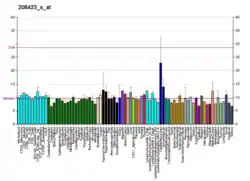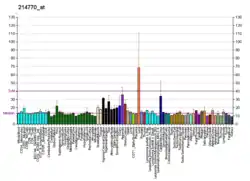MSR1
MSR1 (англ. Macrophage scavenger receptor 1; CD204) — мембранный белок, скавенджер-рецептор макрофагов, продукт гена MSR1[1][2].
Функции
Белок MSR1 относится к классу A макрофагальных скавенджер-рецепторов. В результате альтернативного сплайсинга образуются три изоформы. Все три изоформы являются тримерными мембранными гликопротеинами, которые играют роль во многих физиологических и патологических процессах, связанных с макрофагами, включая атеросклероз, болезнь Альцгеймера и иммунную реакцию. Ранее считалось, что рецептор экспрессирован только на макрофагах, но позже был обнаружен также на некоторых типах дентритных клетках[3].
Изоформы 1 и 2 являются функциональными рецепторами, которые опосредуют эндоцитоз липопротеинов низкой плотности. Изоформа 3 не приводит к интернализации липопротеинов низкой плотности. В результате изменённого внутриклеточного процессинга эта изоформа остаётся в эндоплазматическом ретикулюме, однако она может ингибировать функционирование активных форм белка за счёт доминантно-негативного эффекта, поэтому предполагается, что изоформа 3 участвует в регуляции скавенджер-рецептора в макрофагах[1].
Литература
- Asaoka H., Matsumoto A., Itakura H., Kodama T. [Structural and function of the human macrophage scavenger receptor] (англ.) // Nippon Rinsho : journal. — 1993. — Vol. 51, no. 6. — P. 1677—1683. — PMID 8391600.
- Naito M., Suzuki H., Mori T., etal. Coexpression of type I and type II human macrophage scavenger receptors in macrophages of various organs and foam cells in atherosclerotic lesions (англ.) // Am. J. Pathol. : journal. — 1992. — Vol. 141, no. 3. — P. 591—599. — PMID 1519666.
- Matsumoto A., Naito M., Itakura H., etal. Human macrophage scavenger receptors: primary structure, expression, and localization in atherosclerotic lesions (англ.) // Proceedings of the National Academy of Sciences of the United States of America : journal. — 1991. — Vol. 87, no. 23. — P. 9133—9137. — doi:10.1073/pnas.87.23.9133. — . — PMID 2251254.
- Emi M., Asaoka H., Matsumoto A., etal. Structure, organization, and chromosomal mapping of the human macrophage scavenger receptor gene (англ.) // J. Biol. Chem. : journal. — 1993. — Vol. 268, no. 3. — P. 2120—2125. — PMID 8093617.
- Ashkenas J., Penman M., Vasile E., etal. Structures and high and low affinity ligand binding properties of murine type I and type II macrophage scavenger receptors (англ.) // J. Lipid Res. : journal. — 1993. — Vol. 34, no. 6. — P. 983—1000. — PMID 8394868.
- Resnick D., Chatterton J. E., Schwartz K., etal. Structures of class A macrophage scavenger receptors. Electron microscopic study of flexible, multidomain, fibrous proteins and determination of the disulfide bond pattern of the scavenger receptor cysteine-rich domain (англ.) // J. Biol. Chem. : journal. — 1996. — Vol. 271, no. 43. — P. 26924—26930. — doi:10.1074/jbc.271.43.26924. — PMID 8900177.
- Hsu H. Y., Hajjar D. P., Khan K. M., Falcone D. J. Ligand binding to macrophage scavenger receptor-A induces urokinase-type plasminogen activator expression by a protein kinase-dependent signaling pathway (англ.) // J. Biol. Chem. : journal. — 1998. — Vol. 273, no. 2. — P. 1240—1246. — doi:10.1074/jbc.273.2.1240. — PMID 9422792.
- Gough P. J., Greaves D. R., Gordon S. A naturally occurring isoform of the human macrophage scavenger receptor (SR-A) gene generated by alternative splicing blocks modified LDL uptake (англ.) // J. Lipid Res. : journal. — 1998. — Vol. 39, no. 3. — P. 531—543. — PMID 9548586.
- Teupser D., Thiery J., Seidel D. Alpha-tocopherol down-regulates scavenger receptor activity in macrophages (англ.) // Atherosclerosis : journal. — 1999. — Vol. 144, no. 1. — P. 109—115. — doi:10.1016/S0021-9150(99)00040-4. — PMID 10381284.
- Nakamura T., Hinagata J., Tanaka T., etal. HSP90, HSP70, and GAPDH directly interact with the cytoplasmic domain of macrophage scavenger receptors (англ.) // Biochem. Biophys. Res. Commun. : journal. — 2002. — Vol. 290, no. 2. — P. 858—864. — doi:10.1006/bbrc.2001.6271. — PMID 11785981.
- Tomokiyo R., Jinnouchi K., Honda M., etal. Production, characterization, and interspecies reactivities of monoclonal antibodies against human class A macrophage scavenger receptors (англ.) // Atherosclerosis : journal. — 2002. — Vol. 161, no. 1. — P. 123—132. — doi:10.1016/S0021-9150(01)00624-4. — PMID 11882324.
- Xu J., Zheng S. L., Komiya A., etal. Germline mutations and sequence variants of the macrophage scavenger receptor 1 gene are associated with prostate cancer risk (англ.) // Nat. Genet. : journal. — 2002. — Vol. 32, no. 2. — P. 321—325. — doi:10.1038/ng994. — PMID 12244320.
- Xu J., Zheng S. L., Komiya A., etal. Common sequence variants of the macrophage scavenger receptor 1 gene are associated with prostate cancer risk (англ.) // Am. J. Hum. Genet. : journal. — 2003. — Vol. 72, no. 1. — P. 208—212. — doi:10.1086/345802. — PMID 12471593.
- Strausberg R. L., Feingold E. A., Grouse L. H., etal. Generation and initial analysis of more than 15,000 full-length human and mouse cDNA sequences (англ.) // Proceedings of the National Academy of Sciences of the United States of America : journal. — 2003. — Vol. 99, no. 26. — P. 16899—16903. — doi:10.1073/pnas.242603899. — . — PMID 12477932.
- Kosswig N., Rice S., Daugherty A., Post S. R. Class A scavenger receptor-mediated adhesion and internalization require distinct cytoplasmic domains (англ.) // J. Biol. Chem. : journal. — 2003. — Vol. 278, no. 36. — P. 34219—34225. — doi:10.1074/jbc.M303465200. — PMID 12819208.
- Miller D. C., Zheng S. L., Dunn R. L., etal. Germ-line mutations of the macrophage scavenger receptor 1 gene: association with prostate cancer risk in African-American men (англ.) // Cancer Research : journal. — American Association for Cancer Research, 2003. — Vol. 63, no. 13. — P. 3486—3489. — PMID 12839931.
- Wang L., McDonnell S. K., Cunningham J. M., etal. No association of germline alteration of MSR1 with prostate cancer risk (англ.) // Nat. Genet. : journal. — 2003. — Vol. 35, no. 2. — P. 128—129. — doi:10.1038/ng1239. — PMID 12958598.
- Nupponen N. N., Wallén M. J., Ponciano D., etal. Mutational analysis of susceptibility genes RNASEL/HPC1, ELAC2/HPC2, and MSR1 in sporadic prostate cancer (англ.) // Genes Chromosomes Cancer : journal. — 2004. — Vol. 39, no. 2. — P. 119—125. — doi:10.1002/gcc.10308. — PMID 14695991.
- Hillman R. T., Green R. E., Brenner S. E. An unappreciated role for RNA surveillance (англ.) // Genome Biol. : journal. — 2005. — Vol. 5, no. 2. — P. R8. — doi:10.1186/gb-2004-5-2-r8. — PMID 14759258.
Примечания
- Entrez Gene: MSR1 macrophage scavenger receptor 1.
- Matsumoto A., Naito M., Itakura H., Ikemoto S., Asaoka H., Hayakawa I., Kanamori H., Aburatani H., Takaku F., Suzuki H. Human macrophage scavenger receptors: primary structure, expression, and localization in atherosclerotic lesions (англ.) // Proceedings of the National Academy of Sciences of the United States of America : journal. — 1990. — December (vol. 87, no. 23). — P. 9133—9137. — doi:10.1073/pnas.87.23.9133. — . — PMID 2251254.
- Herber D. L., Cao W., Nefedova Y., Novitskiy S. V., Nagaraj S., Tyurin V. A., Corzo A., Cho H. I., Celis E., Lennox B., Knight S. C., Padhya T., McCaffrey T. V., McCaffrey J. C., Antonia S., Fishman M., Ferris R. L., Kagan V. E., Gabrilovich D. I. Lipid accumulation and dendritic cell dysfunction in cancer (англ.) // Nat. Med. : journal. — 2010. — August (vol. 16, no. 8). — P. 880—886. — doi:10.1038/nm.2172. — PMID 20622859.



